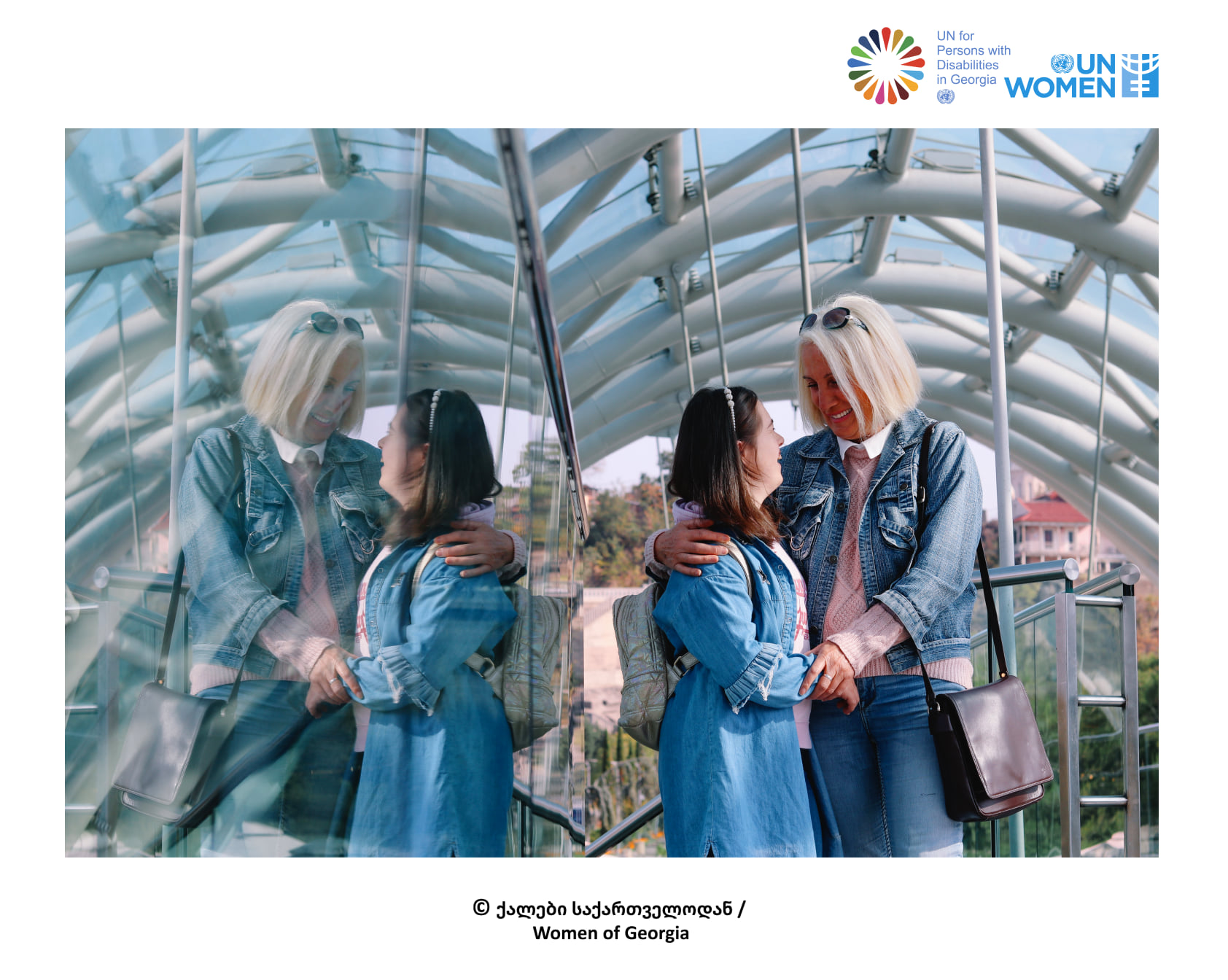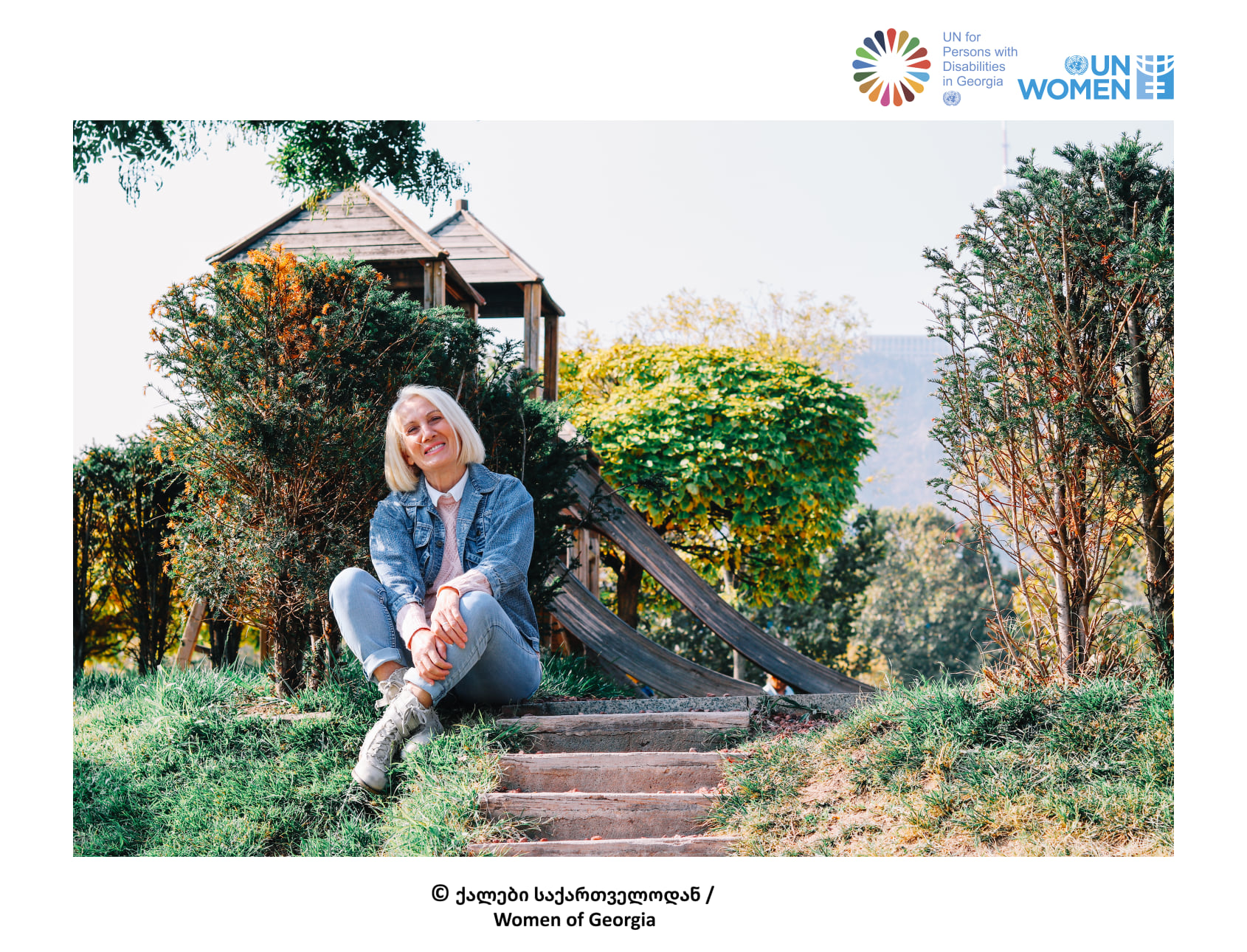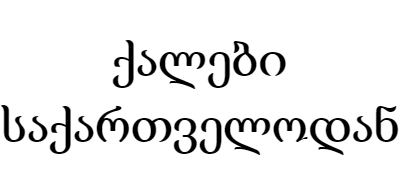October 30, 2020 In J-P, Mothers of disabled children, Regions, Tbilisi, Themes, Women with disabilities as agents
Nana Cherkezishvili, 60 years old, Tbilisi
When Mariam was born…
“When Mariam was born, the doctors didn’t bring her to me for several days. They tried to get me used to the fact that the baby wasn’t healthy, she wouldn’t survive and they assured me it would be the best solution for me to leave her there. 4 days later, at my urgent request, I met her for the first time – she was an amazingly beautiful baby, but so weak that she couldn’t eat independently. It took a lot of struggle to take my baby out of the hospital. None of the doctors agreed with me. Down syndrome was the suspected diagnosis, by which we, mother and the child, moved to Iashvili Hospital and stayed there for a month. My life there was horrible – I had to strong-arm doctors every day to keep the baby with me. Due to stress, my milk dried up and I took Mariam from ward to ward to other mothers, who would breastfeed her. During this one month, I thought a lot about what my life would be like with Down syndrome in it, I gathered my strength, planned everything in my head – I even saw what Mariam’s life would be like when I’ll be 60 and I strongly decided, that despite these objections, my child would stay with me.
At that time, there was a lack of information about Down syndrome. Imagine, even pediatricians couldn’t provide me with any information about child care. On the opposite, they mischaracterized the abilities of people with Down syndrome and I too convinced myself, that according to them, Mariami could never know me – she wouldn’t be able to call me mother or be able to walk. I was educating myself – I read a lot of literature and articles about the syndrome and realized it was nothing like how the doctors described it. I knew life with Mariam would be difficult, and would need a lot of therapeutic work, but it would be productive and beautiful. Mariam is now 17 years old.
 What I gave up…
What I gave up…Mariam is my second child. At first, all the family members – my husband, my elder son – were involved in taking care of the baby, but I soon realized that Mariam needed much more – she constantly needed someone by her side to help her, who’d take her to various therapy sessions, to a speech therapist, to a masseur, and, when she’d grow up, take her to school and to various private lessons. We didn’t have anyone else in the family and all the burden fell on me. It was very difficult for me to manage to be Mariam’s mother and take care of my career at the same time. So, I soon decided to give up everything and put myself at my child’s service. I’m a sewing technologist by profession and at that time I had a great income. Obviously, I would have a good income nowadays as well, but I completely adapted to Mariami’s needs. I decided that since I made this sacrifice from the very beginning – to give up my personal life, I would continue to do it to the end.
My friends have reprimanded me for sacrificing everything for the child, but I couldn’t see any other solution. After I left my job, all the weight of supporting our family financially fell on my husband. Mariam was barely one year old when our family received the status of a socially vulnerable family, which we still have. Sometimes I think about how would we ever been able to raise a child without that status when she needs so many medical or social services. These services are partially funded by the state, but requires a lot of resources from the parent – to take her from therapy to therapy, working individually with the child, driving her to school and lessons, helping her do her homework. Probably, the best solution would be to put it all together in one place, like how it’s done in developed countries, and parents have more time for themselves as well. Such complex services are expensive here and we don’t have the luxury to pay for it.
Mariam’s future
My goal is to know that when I’m gone, Mariam won’t be a burden on her brother and on the community. That’s actually why I work so hard for her development. I want her to have her profession and a small, but completely her own, income. Children with Down syndrome, like most other children with disabilities, are getting incomplete, secondary education. Often, the reason for this is that the more difficult the program gets, the more insurmountable it is for children with special educational needs. The program isn’t adapted well and such children waste time sitting in the classroom. My goal is for Mariam to get a full higher education because it’s vital for her to socialize, to learn how to communicate with people, which will help on her future life path.
 Unfortunately, our education system isn’t ready for inclusive education – imagine, there is only one special teacher in the whole school, who works with children with special needs in all classes. Mariam is going through a very difficult program and in fact, no one pays attention to her. I help her – I first read the texts and then I explain to Mariam in a language she can understand. Actually, the system should be doing this. Now, with several teachers, we agreed on such a method – When explaining new material, each teacher will prepare a test and Mariam will also learn the basic topics according to this test. But you can’t expect to ask all teachers to do such work.
Unfortunately, our education system isn’t ready for inclusive education – imagine, there is only one special teacher in the whole school, who works with children with special needs in all classes. Mariam is going through a very difficult program and in fact, no one pays attention to her. I help her – I first read the texts and then I explain to Mariam in a language she can understand. Actually, the system should be doing this. Now, with several teachers, we agreed on such a method – When explaining new material, each teacher will prepare a test and Mariam will also learn the basic topics according to this test. But you can’t expect to ask all teachers to do such work.In the upper grades, nobody pays attention to the development of children with disabilities. Often, when I went to her school, I asked the administration to involve Mariam in the lesson process by getting to know with the material adapted for her, but they only do this as a show, for example, when they have a guest. I don’t want Mariam to be different. I put a lot of effort into her development and now is the time for the state to take care of her and promote the integration of young people like her.
We and the pandemic
The isolation caused by the pandemic was difficult for everyone, but especially for us. The online learning process makes no sense for a young person with a disability. Mariam doesn’t feel involved and doesn’t feel that she is part of this so she often skips the lesson or becomes so bored that she just falls asleep. I’m very nervous because I see that my work for so many years is heading to waste. Being locked up and staying inactive at home affects Mariam’s mental development – socializing at school and on lessons gave her knowledge, skills, and the possibility to get to know people. Now, when locked up at home, she’s even forgetting skills that she has learned so far.
Here, too, I have a note for the education system – no one is thinking about different kinds of online lessons for young people with special needs using engagement methods. We are in a hopeless situation and I feel helpless.
The pandemic will pass and I’ll have to think about Mariam’s independent life again – how will she live, who will support her, and will she be protected by the state? I, as the mother of a young girl with a disability, have other worries as well: Mariam is a very trusting person, she can’t exhibit aggressive behavior and can’t defend herself. She is practically defenseless from the whole world. In our country, where girls and women are victims of violence on a daily basis, how can I, as a mother, protect my child from possible violence? Studies have shown that girls and women with disabilities are twice more likely to be victims of violence than people with typical development. I teach Mariam how to live independently, but will she find an environment where she can live safely?! I have so many questions to the state – I, as a mother of a young person with disabilities, – but I don’t have answers yet.’’
Author: Maiko Chitaia
Photo: Geda Darchia
Translation: Mariam Kajrishvili
The project is implemented with the support of UN Women and with the financial support of the Joint Fund for Sustainable Development Goals, within the UN Joint Program – “Transformation of Social Security for People with Disabilities in Georgia”.
The views expressed in the publication are those of the author (s) and do not necessarily reflect the views of the United Nations Women or the Joint Foundation for Sustainable Development.

